The Flat Coated Retriever Rescue Network: News in November 2023
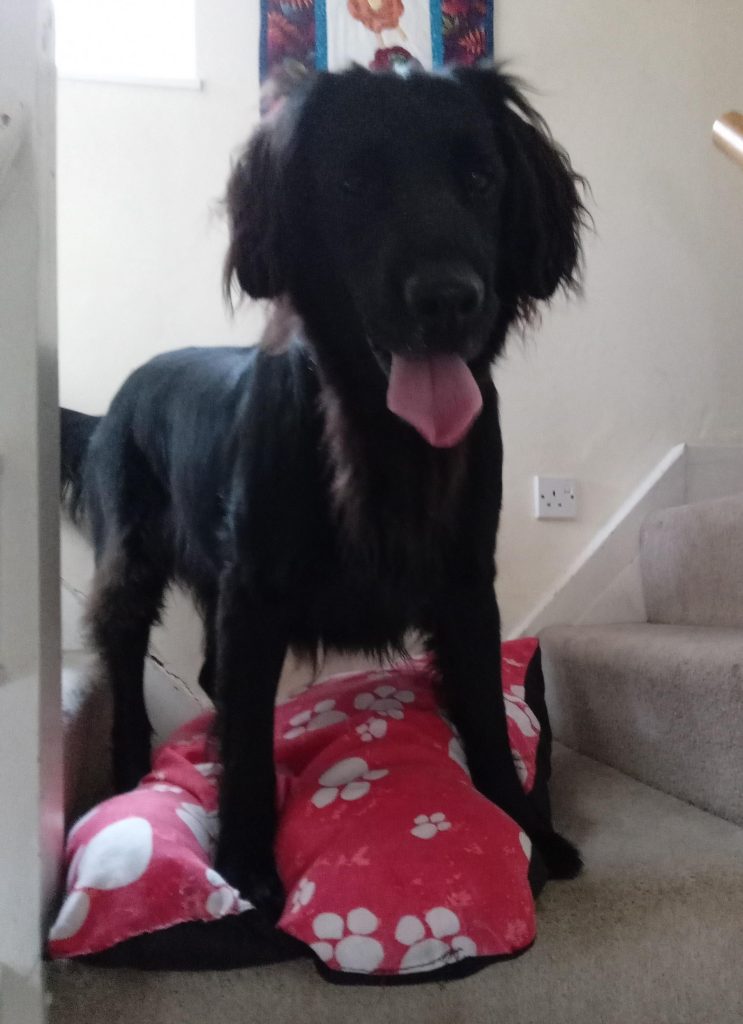
Picture: Max at winter festival holiday time. “Are you packed and ready? I’ve got my bed so let’s go. New Brunswick is good at this time of year!”
General news
Greetings from the Flat Coated Retriever Rescue Network (FCRRN) as the meteorological winter approaches and we say goodbye to the autumn. We are very grateful to the supporters who have shared specific information about situations involving flat coated retrievers, for examples, in this newsletter see the news about Alfie, Benson, and the Yorkshire mystery.
Also we extend our thanks to our supporters and other readers of the newsletters(1 – 9) for their continuing interest and particularly for their many comments.
Several supporters commented on Fergus, a three years young flat coated retriever, who featured in “Saving Lives At Sea” on BBC2 on November 9th 2023. He was rescued and went home with his guardians. Alas, unrelated to his experience at sea, he died soon afterwards from a cardiac condition.
One of the FCRRN’s supporters is a veterinary cardiologist and she tells me that she receives a disproportionate number of flat coated retriever referrals. Clearly there will be a referral bias (flat coated retriever guardians being the type of people who request specialist opinions) but it is another cause for potential concern within our breed.
For balance though it should be stated that it could be similar to the situation with cancers in flat coated retrievers where there is a danger of mislabelling flat coated retrievers as being a breed at high risk of cancers because many of their human companions care so much for their dogs that they take extra steps to diagnose and report cancers compared to the human companions of other breeds(4,7).
Internet prices for pure bred flat coated retriever puppies continue to be about £1600 (+/- £200). Animal rescue centres are receiving many dogs pushing them towards full capacity and the costs in the centres have increased ahead of inflation for veterinary fees, energy consumption, food, inter alia (Norris, 2023). There are regular advertisements on the Internet for pedigree flat coated retrievers for sale e.g. recently an asking price of £650 for a male aged 18 months due to changed domestic circumstances. It seems sad that the surrendering guardian did not surrender him to a rescue organisation e.g. the Flat Coated Retriever Society’s rescue, rehousing and welfare scheme, Black Retriever Cross Rescue, FCRRN, or to a rescue centre, in contrast to the guardians of Alfie and of Benson.
Res ipsa loquitur.
Alfie: A home is needed
Alfie is nine years young, he is a flat coated retriever cross, and he is looking for a home. He is currently being cared for at Warrington Animal Welfare and their contact details are given below*.
The full details about Alfie are on their website – https://warringtonanimalwelfare.org.uk/alfie-3
Alfie’s details are also on this website – https://www.dogsblog.com/alfie-391/
In summary, it seems Alfie is a mature, well-adjusted dog who needs a home with a guardian and no other dog.
I feel greatly for Alfie; in other circumstances he is the type of veteran to whom we would happily offer a home. Obviously here would not suit him due to the presence of three other flat coated retrievers.
Warrington might not be close to some of our supporters but our supporters have many friends in the flat coated retriever community, maybe in Cheshire, so perhaps someone would be willing to give Alfie a home and they can approach Warrington Animal Welfare directly?
* Warrington Animal Welfare
Slutchers Lane, Warrington WA1 1NA
Phone: 01925 748638
https://warringtonanimalwelfare.org.uk/
Benson: A home is needed
Benson (pseudonym) is a male flat coated retriever cross golden retriever who was born in July 2022. His guardian is searching for a home with experience of retrievers either for Benson on his own or with a confident, older female dog. He is used to having the company of someone at home for most of the day.
Benson is 17 months young; he is very friendly with a lovely nature and, characteristically for the breeds, he is boisterous. He is neutered. He needs to continue his training and to take plenty of exercise as well as to enjoy his home comforts including a warm bed.
I know that many of our supporters already have a flat coated retriever so offering a home to Benson might not be feasible. However one of many strengths of the FCRRN is that we have many committed people who know others who know others and so on; maybe there is a guardian who can offer Benson a home?
Please contact the FCRRN or pass on the details of Benson to potential adopters who can contact the FCRRN: walesandwm@gmail.com
Yorkshire mystery: Four flat coated retrievers
Several of the FCRRN’s supporters reported seeing something somewhere on social media about four flat coated retrievers in Yorkshire who possibly needed a home. Strangely no-one has been able to track down the details despite a wide range of inquiries. It is a Yorkshire mystery.
The lack of specific information about these four flat coated retrievers is surprising. If such an unfortunate situation arose that four dogs needed a home together then it would be challenging but not impossible to find somewhere. There are many good homes seeking flat coated retrievers.
Misty and Kane: An update
Readers will recall that Misty and Kane (pseudonyms) needed a home. Misty is a female flat coated retriever who is now 11 years young and Kane is a male flat coated retriever who is five years young.
Jan Egginton and colleagues, on behalf of the Flat Coated Retriever Society’s rescue, rehousing and welfare scheme, found Misty and Kane a home together. It is nearly three months since they moved and Jan informs me that they are having “the best life.” On their first weekend they swam in the sea and river which helped them to settle in. Misty and Kane and their adoptive guardians are very happy.
Max: Habits, cobs, and mud
Max (pseudonym) is a male flat coated retriever who celebrated his seventh birthday recently. Following the trauma of his early years(7) he has continued to gain confidence since his rescue three years ago.
There was a question in the August newsletter(9) about whether flat coated retrievers retain a habit that is no longer needed. The question was prompted by the way that Max still jumps the site of an electric fence even though the fence has long gone.
One of the FCRRN’s most active supporters wrote: “I have enjoyed reading the newsletter especially Max’s story that brought a loud peel of laughter from me especially when viewing the photo of him jumping the non-existent fence. It reminded me that many years ago my wife and our youngest daughter were keen riders and they had several ponies and horses. The passage of three or four Equus caballus would cause the gateway to the fields to poach badly in winter and would make access for humans difficult. To that end electric fencing was placed several feet back to solve the problem. Our rescue flat coated retriever at that time was Bertram (pseudonym), still only two or three years old, for whom the mud was not an obstacle. He enjoyed jumping the gate until the installation of electric fencing when his nose touched the fencing which had been switched on. Poor soul gave out a series of pitiful yelps and hightailed it across the field through the natural hedge back around to the gate. He continued to enter and leave by the natural hedge even in the summer when the electric fence was stored away and the gate fully open.”
Pip, three years young flat coated retriever, displayed a similar habit last September when he encountered an electric fence near the cottage we rented in Gloucester. For the rest of the holiday he walked round the edge of the field even though the fence had been removed.
I think from a limited study (n = 3; Max, Bertram and Pip) the question can be answered i.e. some flat coated retrievers do retain in their memory the need to avoid a fence which justifies the behaviour being called a habit!
Max has developed a penchant for corn on the cob. Recently a crop of several hundred acres was cut in the fields next to his home. The work took 15 hours and the mud on the fields and roads was extraordinary.
There were inevitably some cobs still intact on the ground and Max has determined how to access the individual golden kernels leaving the outer leaves and central husk.
He offers these tips on the best method for eating corn on the cob –
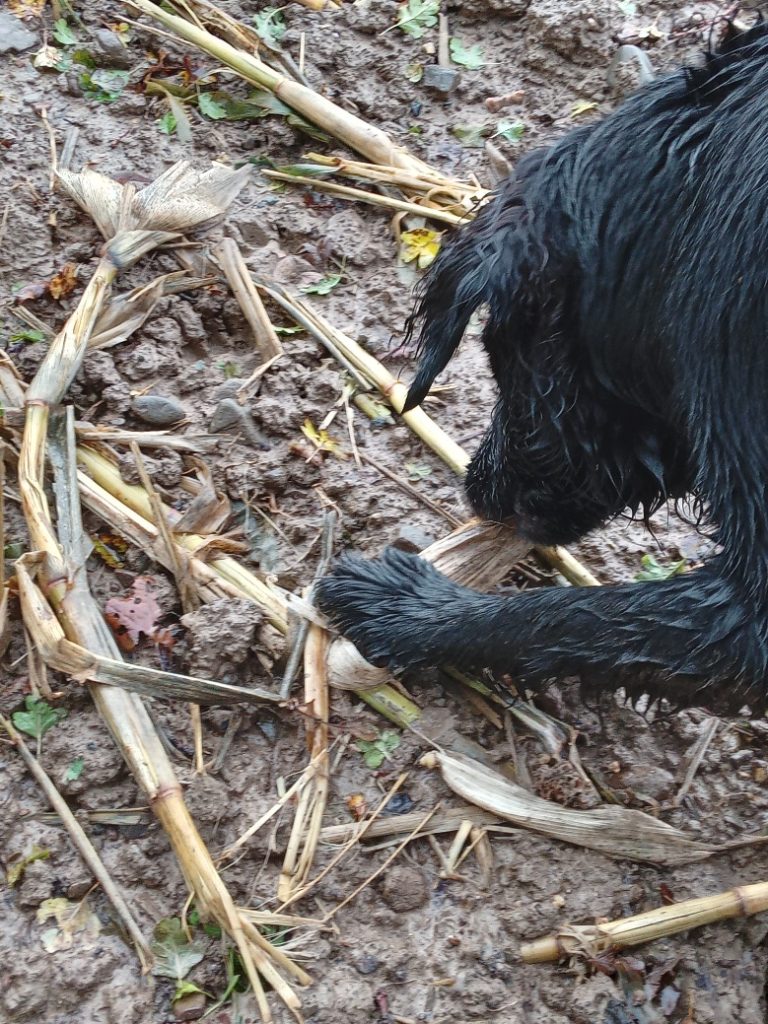
Picture: Strip the outer leaves
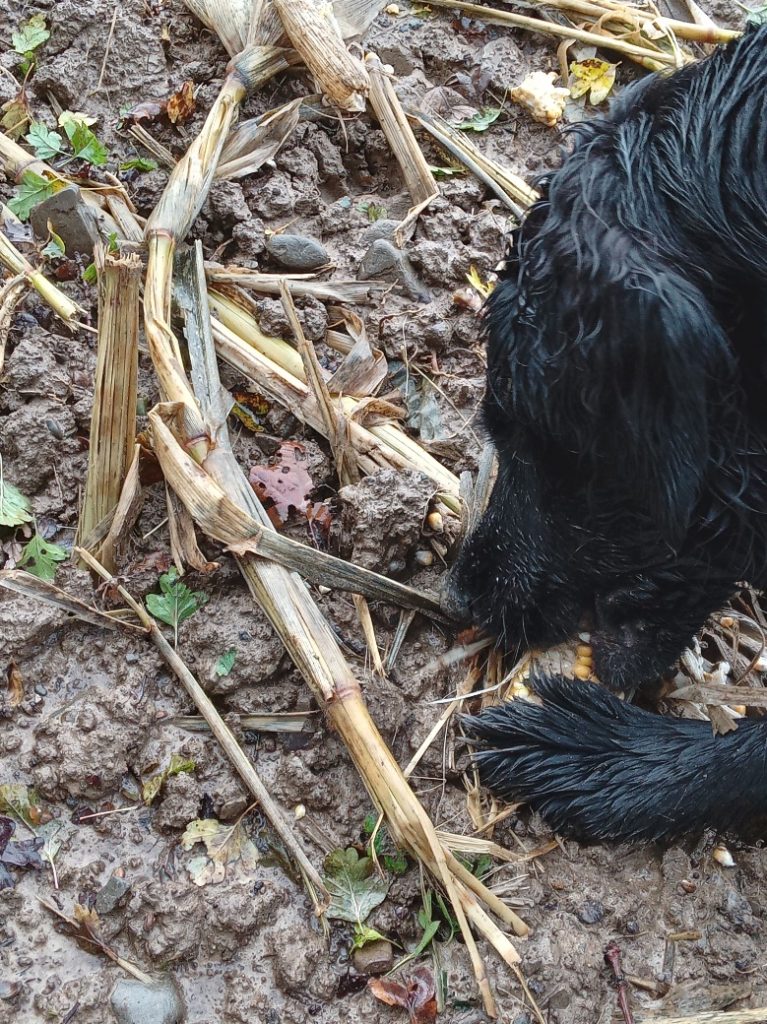
Picture: Nibble gently at the kernels, turning the cob as required to get them all
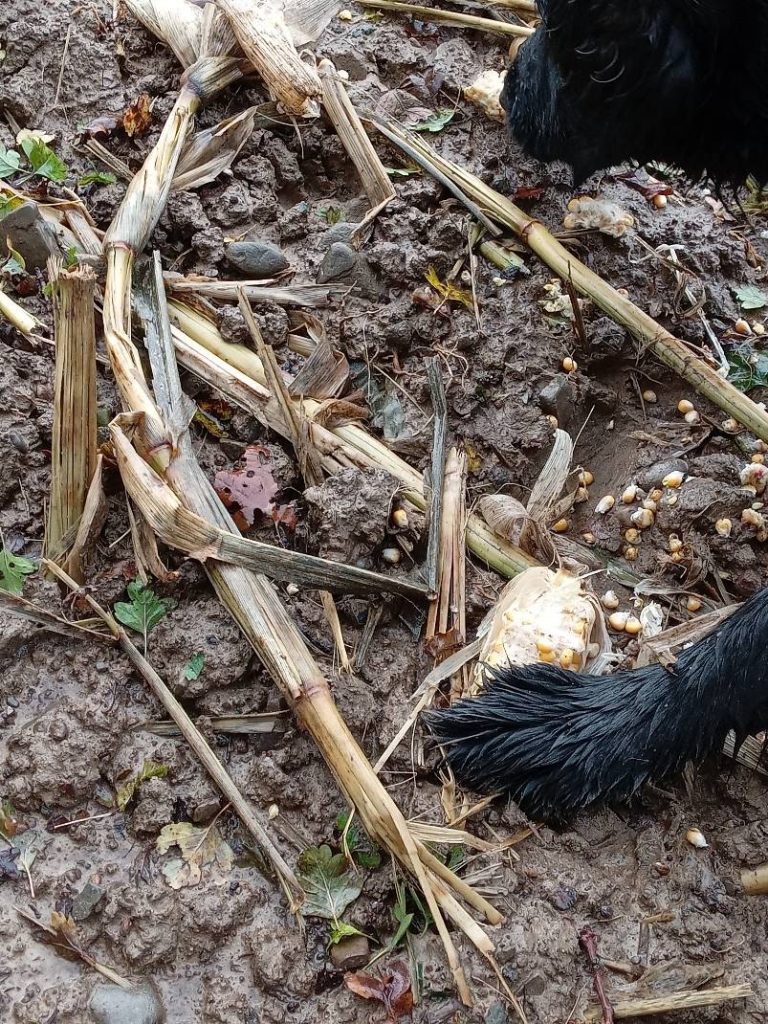
Picture: Leave the centre husk, not tasty!
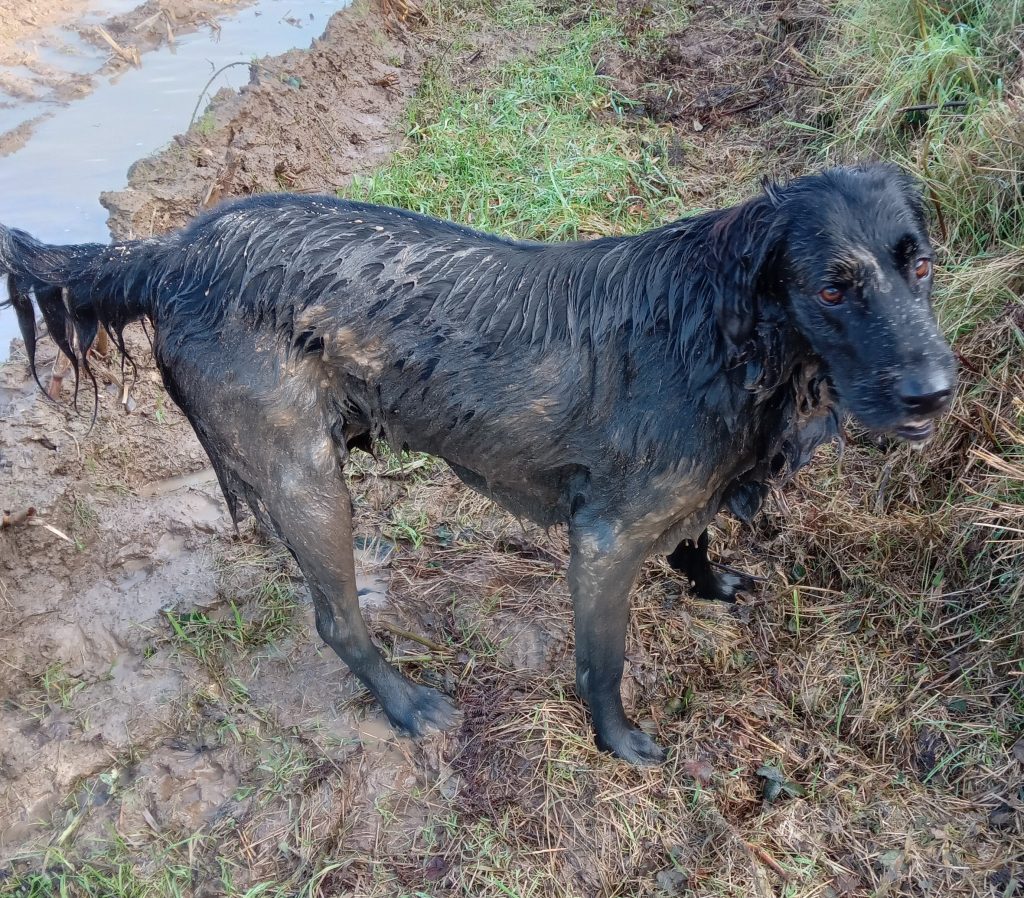
Picture: Makes a tasty snack after a good roll in a muddy pool. Look very carefully and the cob can be seen in my mouth. I look “hangdog” but in reality I am smiling
Canine stem cell therapy
Feedback on the piece in the August newsletter(9):
• “I read with interest your piece about stem cell therapy. Thank you for explaining in detail the procedure in layman’s language. Prior to this I had heard and skimmed articles but was not clear about its effects, range and safety aspects as you say.”
• “Stem cell therapy is something we used so much in my time as an equine vet but very little in first opinion veterinary practice. I too find it very interesting and think there will be lots of developments and applications with it in the next few years.”
• “I have only skimmed the stem cell article and will give it some more time and thought. A first comment is that your approach to the assessment of the possible treatment for one of your dogs makes sense to me.”
• “I read this report all through twice and while I do not have a wealth of medical knowledge I feel I have a better understanding of the issues surrounding this therapy, its potential benefits and how these are achieved. It will be interesting to see where this leads in the future.”
• “What an interesting newsletter and what a lot of work you put into it. I was particularly interested in the piece on stem cell implantation.”
• “I completely agree with what you say in the newsletter about the need for standards for veterinary stem cell use. There are a lot of companies doing it out there and not all are equally reputable, from what I can tell. When the science is sound, it seems to have the potential of reversing joint disease progression, but there needs to be more experience and evidence generated in order to determine which animals would benefit from it the most, in my opinion.”
Here are some links to Boehringer Ingelheim’s website that describes some recent activities on equine stem cells –
Editor’s note: The pieces from the Boehringer Ingelheim website are very apposite. In my view, there is a need for a cautious approach to veterinary stem cell therapy because of its limited successes. It must be difficult for guardians to assess the probabilities of effectiveness and safety in the context of autologous transplantation of stem cells. People so much want to help their animal companions (Belshaw et alia, 2020) and there could be compromises to animal welfare.
Blood doning
Our three rescue flat coated retrievers have continued to donate blood through the Pet Blood Bank. Lucie, Rose and Pip seem to thoroughly enjoy the experience – warm attention from the Pet Blood Bank team, plentiful treats, meeting other donors in a supervised way, the road trip together, inter alia.
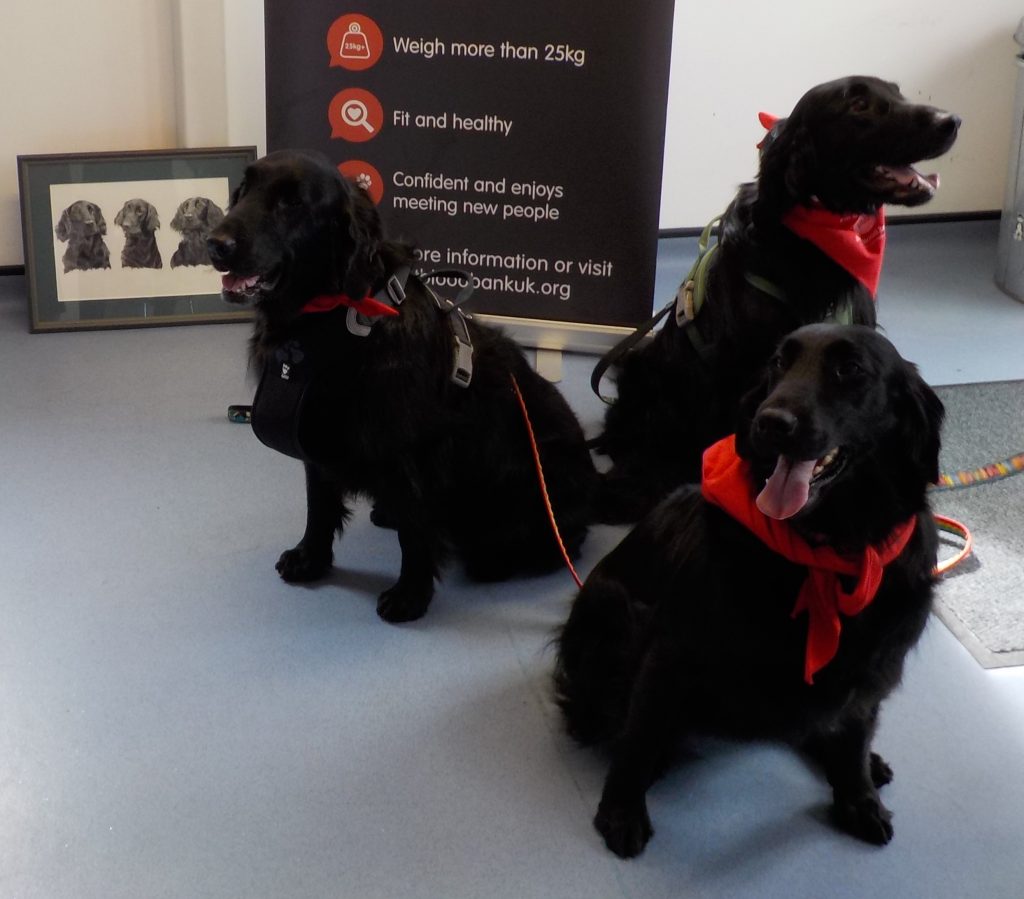
Picture: The trio with their portraits created by Eleanor Jones. Eleanor can be contacted via email: ellunart@outlook.com and via: https://www.deviantart.com/ellestration
Lucie has retired from blood doning following the recent donation because the age limit is eight years. She has donated five times in 2023 and each unit of blood can potentially benefit four animals in need so 20 animals could have been helped by Lucie.
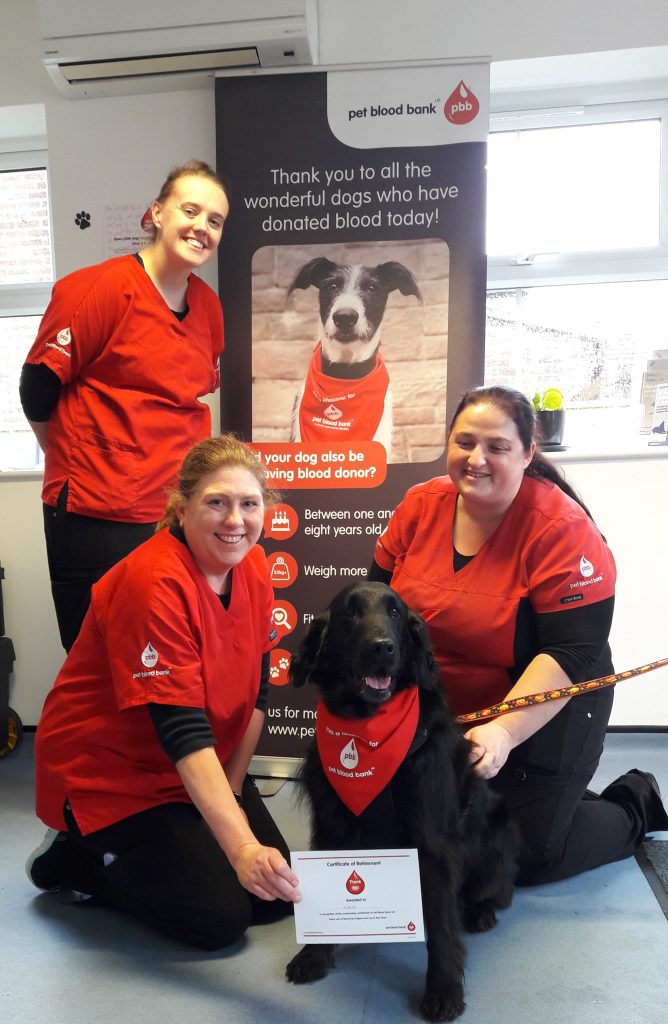
Picture: Lucie receiving her retirement certificate from the team. Photo credit: courtesy of Dr. Lara Howe, clinical supervisor, Pet Blood Bank
Flat coated retrievers are especially good donors because of their nature (sic) and many are Dog Erythrocyte Antigen (DEA) 1.1 negative which makes them universal donors.
The Pet Blood Bank are a registered charity (Scottish Charity No: 037745) and they use fundraising to subsidise their costs. The costs charged to vets for blood or platelets cover the funds needed to run the service and the Pet Blood Bank have an agreement with vets who use the donated products that there is no mark-up charge to guardians. See: https://www.petbloodbankuk.org/about-us/our-commitment-to-welfare/
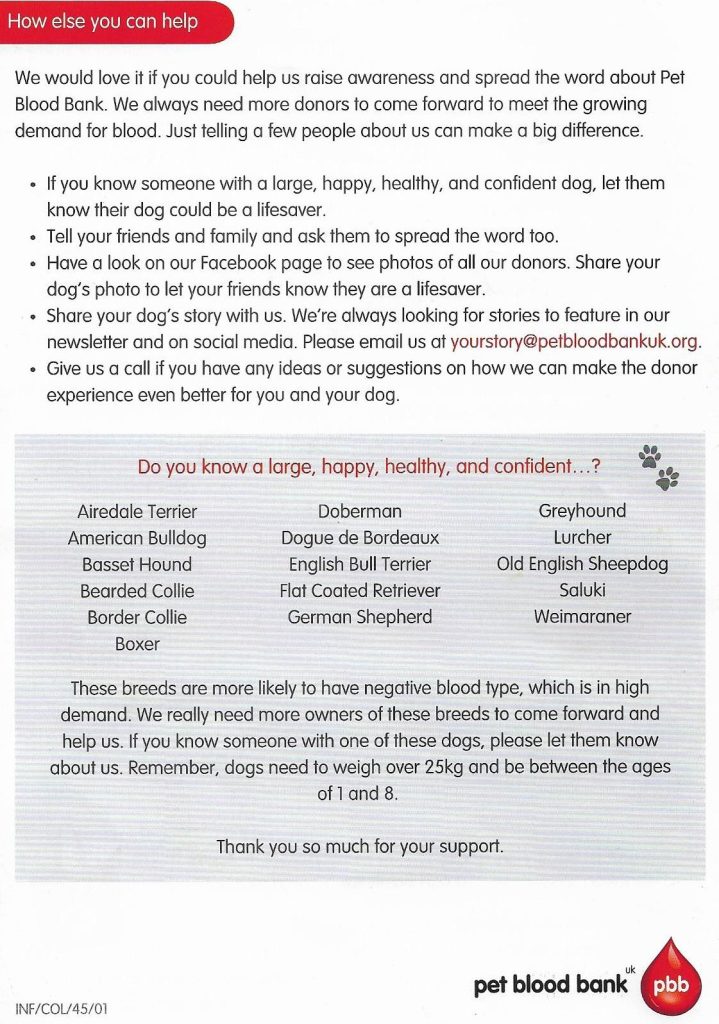
Picture: Pet Blood Bank; extract from the information sheet
Please consider your flat coated retriever as a blood donor; there is further information at:
https://www.petbloodbankuk.org/
And finally
The Flat Coated Retriever Rescue Network send our best wishes for the winter especially for the winter festival holiday to all our supporters, their flat coated retrievers and their other companions.
Please send us any snippets of news about our beloved breed and their relatives so that they can be shared with our community.
Also, please could you remember the Flat Coated Retriever Rescue Network if, via any route, you learn that a surrender or adoption is being considered?
Dr. Iain J. Robbé
On behalf of the Flat Coated Retriever Rescue Network (FCRRN)
Email: walesandwm@gmail.com
http://www.iainrobbe.com/fcrrn_10/
“Rescues R Us”
Experts: none of the FCRRN is acting in the capacity of an expert; each contributor is offering their advice based on accessible evidence. If you are concerned about any subject in the newsletters then you should consult a veterinary professional, legal professional or other professional.
© 2023 Flat Coated Retriever Rescue Network
(1) http://www.iainrobbe.com/fcrrn_01/
(2) http://www.iainrobbe.com/fcrrn_02/
(3) http://www.iainrobbe.com/fcrrn_03/
(4) http://www.iainrobbe.com/fcrrn_04/
(5) http://www.iainrobbe.com/fcrrn_05/
(6) http://www.iainrobbe.com/fcrrn_06/
(7) http://www.iainrobbe.com/fcrrn_07/
(8) http://www.iainrobbe.com/fcrrn_08/
(9) http://www.iainrobbe.com/fcrrn_09/
Belshaw, Z., et alia. (2020). “You Can Be Blind Because Of Loving Them So Much:” The Impact on Owners in the United Kingdom of Living with a Dog with Osteoarthritis.
https://doi.org/10.1186/s12917-020-02404-5
Norris, S. (2023, October 29). Animal Refuges Are “Full to Bursting.” Observer, p. 31.
